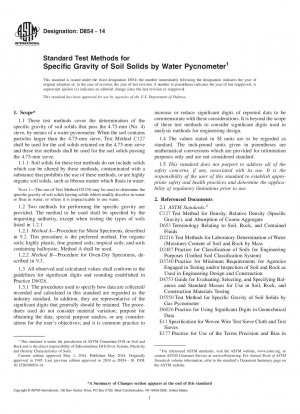ASTM D854-14
Standard Test Methods for Specific Gravity of Soil Solids by Water Pycnometer
- Standard No.
- ASTM D854-14
- Release Date
- 2014
- Published By
- American Society for Testing and Materials (ASTM)
- Status
- Replace By
- ASTM D854-23
- Latest
- ASTM D854-23
- Scope
4.1 The specific gravity of a soil solids is used in calculating the phase relationships of soils, such as void ratio and degree of saturation.
4.1.1 The specific gravity of soil solids is used to calculate the density of the soil solids. This is done by multiplying its specific gravity by the density of water (at proper temperature).
4.2 The term soil solids is typically assumed to mean naturally occurring mineral particles or soil like particles that are not readily soluble in water. Therefore, the specific gravity of soil solids containing extraneous matter, such as cement, lime, and the like, water-soluble matter, such as sodium chloride, and soils containing matter with a specific gravity less than one, typically require special treatment (see Note 1) or a qualified definition of their specific gravity.
4.3 The balances, pycnometer sizes, and specimen masses are established to obtain test results with three significant digits.
Note 2—The quality of the result produced by these test methods is dependent on the competence of the personnel performing it, and the suitability of the equipment and facilities used. Agencies that meet the criteria of Practice D3740 are generally considered capable of competent and objective testing/sampling/inspection/etc. Users of these test methods are cautioned that compliance with Practice D3740 does not in itself assure reliable results. Reliable results depend on many factors; Practice D3740 provides a means of evaluating some of those factors.1.1 These test methods cover the determination of the specific gravity of soil solids that pass the 4.75-mm (No. 4) sieve, by means of a water pycnometer. When the soil contains particles larger than the 4.75-mm sieve, Test Method C127 shall be used for the soil solids retained on the 4.75-mm sieve and these test methods shall be used for the soil solids passing the 4.75-mm sieve.
1.1.1 Soil solids for these test methods do not include solids which can be altered by these methods, contaminated with a substance that prohibits the use of these methods, or are highly organic soil solids, such as fibrous matter which floats in water.
Note 1—The use of Test Method D5550 may be used to determine the specific gravity of soil solids having solids which readily dissolve in water or float in water, or where it is impracticable to use water.1.2 Two methods for performing the specific gravity are provided. The method to be used shall be specified by the requesting authority, except when testing the types of soils listed in 1.2.1
1.2.1 Method A—Procedure for Moist Specimens, described in 9.2. This procedure is the preferred method. For organic soils; highly plastic, fine grained soils; tropical soils; and soils containing halloysite, Method A shall be used.
1.2.2 Method B—Procedure for Oven-Dry Specimens, described in 9.3.
1.3 All observed and calculated values shall conform to the guidelines for significant digits and rounding established in Practice D6026.
ASTM D854-14 Referenced Document
- ASTM C127 Standard Test Method for Density, Relative Density (Specific Gravity), and Absorption of Coarse Aggregate
- ASTM D2216 Standard Test Method for Laboratory Determination of Water (Moisture) Content of Soil and Rock by Mass
- ASTM D2487 Standard Test Method for Classification Of Soils For Engineering Purposes
- ASTM D3740 Standard Practice for Minimum Requirements for Agencies Engaged in the Testing and/or Inspection of Soil and Rock as Used in Engineering Design and Construction
- ASTM D4753 Standard Specification for Evaluating, Selecting, and Specifying Balances and Scales for Use in Soil, Rock, and Construction Materials Testing
- ASTM D5550 Standard Test Method for Specific Gravity of Soil Solids by Gas Pycnometer
- ASTM D6026 Standard Practice for Using Significant Digits in Geotechnical Data
- ASTM D653 Standard Terminology Relating to Soil, Rock, and Contained Fluids
- ASTM E11 Standard Specification for Wire Cloth and Sieves for Testing Purposes
- ASTM E177 Standard Practice for Use of the Terms Precision and Bias in ASTM Test Methods
- ASTM E691 Standard Practice for Conducting an Interlaboratory Study to Determine the Precision of a Test Method
ASTM D854-14 history
- 2023 ASTM D854-23 Standard Test Methods for Specific Gravity of Soil Solids by the Water Displacement Method
- 2014 ASTM D854-14 Standard Test Methods for Specific Gravity of Soil Solids by Water Pycnometer
- 2010 ASTM D854-10 Standard Test Methods for Specific Gravity of Soil Solids by Water Pycnometer
- 2006 ASTM D854-06e1 Standard Test Methods for Specific Gravity of Soil Solids by Water Pycnometer
- 2006 ASTM D854-06 Standard Test Methods for Specific Gravity of Soil Solids by Water Pycnometer
- 2005 ASTM D854-05 Standard Test Methods for Specific Gravity of Soil Solids by Water Pycnometer
- 2002 ASTM D854-02 Standard Test Methods for Specific Gravity of Soil Solids by Water Pycnometer
- 2000 ASTM D854-00e1 Standard Test Methods for Specific Gravity of Soil Solids by Water Pycnometer
- 2000 ASTM D854-00 Standard Test Methods for Specific Gravity of Soil Solids by Water Pycnometer

Copyright ©2024 All Rights Reserved